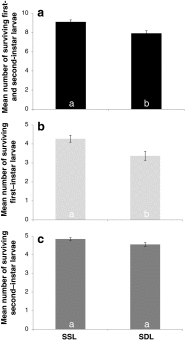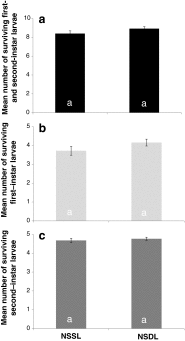Effects of kinship or familiarity? Small thrips larvae experience lower predation risk only in groups of mixed-size siblings
- PMID: 24833813
- PMCID: PMC4018515
- DOI: 10.1007/s00265-014-1715-x
Effects of kinship or familiarity? Small thrips larvae experience lower predation risk only in groups of mixed-size siblings
Abstract
In many species of insects, larvae are distributed in an aggregated fashion. As they may differ in size and size matters to predation risk, small larvae may be less likely to fall prey to predators when near large and therefore better-defended larvae. We hypothesize that the small larvae may profit even more when these large larvae are siblings. We tested this hypothesis on kinship-dependent survival in groups of larvae of the Western flower thrips (Frankliniella occidentalis) exposed to a predatory mite (Iphiseius degenerans). Our experiments showed that small larvae in sibling groups survive significantly better than in non-sibling groups, but only when such groups consisted of a mixture of small and large larvae. To test whether the survival effect we found is due to familiarity of thrips larvae growing up together (i.e. on one leaf), we also measured survival in sibling groups of larvae grown up on different leaves and in non-sibling groups of larvae grown up on the same leaf. These experiments showed an increased survival of small thrips larvae only in groups of sibling larvae from the same leaf. Non-sibling larvae did not show an increased survival when they come from the same leaf. Our results indicated that the increased survival in sibling groups was only partly due to the familiarity effect we tested. Growing up together did not return the same survival effect for non-siblings as it did for siblings. We conclude that growing up together is a necessary but not sufficient condition for discrimination in thrips larvae.
Keywords: Frankliniella occidentalis; Iphiseius degenerans; Kin discrimination; Non-social insects; Predation risk; Size structure.
Figures





Similar articles
-
The benefits of clustering eggs: the role of egg predation and larval cannibalism in a predatory mite.Oecologia. 2002 Mar;131(1):20-26. doi: 10.1007/s00442-001-0846-8. Epub 2002 Mar 1. Oecologia. 2002. PMID: 28547506
-
Herbivore benefits from vectoring plant virus through reduction of period of vulnerability to predation.Oecologia. 2008 Jul;156(4):797-806. doi: 10.1007/s00442-008-1027-9. Epub 2008 Apr 8. Oecologia. 2008. PMID: 18392858 Free PMC article.
-
Ontogenetic shifts in intraguild predation on thrips by phytoseiid mites: the relevance of body size and diet specialization.Bull Entomol Res. 2004 Dec;94(6):577-84. doi: 10.1079/ber2004329. Bull Entomol Res. 2004. PMID: 15541196
-
Biotic resistance limits the invasiveness of the western flower thrips, Frankliniella occidentalis (Thysanoptera: Thripidae), in Florida.Insect Sci. 2016 Apr;23(2):175-82. doi: 10.1111/1744-7917.12250. Epub 2015 Sep 23. Insect Sci. 2016. PMID: 26149353 Review.
-
Paternal kin discrimination: the evidence and likely mechanisms.Biol Rev Camb Philos Soc. 2007 May;82(2):319-34. doi: 10.1111/j.1469-185X.2007.00011.x. Biol Rev Camb Philos Soc. 2007. PMID: 17437563 Review.
Cited by
-
Phytoseiid predatory mites can disperse entomopathogenic fungi to prey patches.Sci Rep. 2019 Dec 19;9(1):19435. doi: 10.1038/s41598-019-55499-8. Sci Rep. 2019. PMID: 31857623 Free PMC article.
-
Role of kin recognition in oviposition preference and cannibalism by the predatory mite Gynaeseius liturivorus.Exp Appl Acarol. 2018 Oct;76(2):149-160. doi: 10.1007/s10493-018-0298-z. Epub 2018 Sep 24. Exp Appl Acarol. 2018. PMID: 30251068
References
-
- Bakker FM, Sabelis MW. Attack success of Amblyseius mckenziei and the stage related defensive capacity of thrips larvae. Neth J Zool. 1987;37:437–437.
-
- Bakker FM, Sabelis MW. How larvae of Thrips tabaci reduce the attack success of phytoseiid predators. Entomol Exp Appl. 1989;50:47–51. doi: 10.1111/j.1570-7458.1989.tb02313.x. - DOI
-
- Blaustein AR, Waldman B. Kin recognition in anuran amphibians. Anim Behav. 1992;44:207–221. doi: 10.1016/0003-3472(92)90027-7. - DOI
LinkOut - more resources
Full Text Sources
Other Literature Sources
Research Materials
